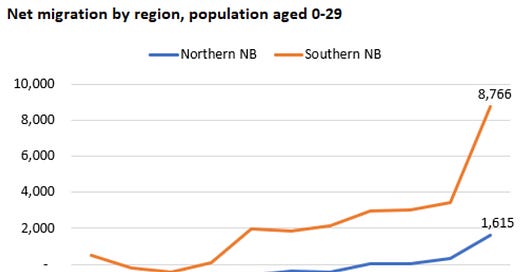My Brunswick News column this week made the case that we need a serious plan for population renewal and economic development in northern New Brunswick. For the most part, the southern part of the province is trending in the right direction but, although there are a few green shoots in the north, all the problems - deindustrialization, workforce aging out, lack of housing, worsening air transportation, lack of inward migration, youth outward migration, are all worse in the north.
But the north has benefitted from the rise in inward migration since the pandemic. If you only look at the population aged 0-29 (a key group if you want population renewal in support of workforce demand), the north went from below the line (more out than in) for many years but starting in 2019 the number ticked slightly positive and in 2022 was decidedly positive. Note this data is based on net inter- and intraprovincial migration as well as immigration and is based on combined county/Census Division data so some of the intraprovincial migration might be wonky.
So we should use this modest positive trend as a starting point for a full court press in the north.
A colleague of mine from way back emailed to say the New Brunswick government has been providing extra incentives for companies to expand in the north for decades and that hasn’t worked - so what else am I looking for?
First, let me remind you of my view of government cash incentives to stimulate private sector investment. There are basically two times government cash should be on the table: 1) If the cash is needed to meet a competitive threat (i.e. another province is outbidding you but there is still a high tax-based ROI on a public investment in the firm/project), then you may have to hold your nose and dole out the cash; and 2) if the cash is needed to meet some kind of private capital market failure - for example, if the banks wont fund a project with the same risk profile in Tignish as they would in Toronto.
The third use of government cash - to basically displace private capital - is not a good use of government money. The problem is that it takes the wisdom of Solomon some times to tell the difference.
The reason for the digression into the tutorial on the use of government incentives is that I have never been sure which $$ doled out in has actually led to new investment and how much was just used to displace private capital. If a company wants to expand and could a) get money from a private investor or bank or b) free/almost free money from government, which would they choose?
What’s needed in the north - as I wrote in my last post about economic development - is a clear assessment of what is truly needed and a plan to make it happen. Fundamentally, it starts with a substantial increase in workforce aged population. As I wrote in the column:
Probably the most concerning demographic statistic of all is the lack of a talent pipeline. In 1986, there were 194 people under the age of 15 in Gloucester County for every 100 aged 60 and older. By 2022, there were only 27 under 15 for every 100 aged 60 and older. This is a breathtaking change of demographic fortunes over four decades.
If it is hard to get your head around this statistic, let me explain it in a different way. If you wanted to reach the 1986 ratio of persons under 15 to persons 60+ in Gloucester County, you would have to grow the current population under the age of 15 from 8,400 to over 60,000. Take a moment to let that sink in.
Now, I am not suggesting that we need to bring in 51,600 young people over night just to Gloucester County. That ratio of young to old people will never happen again but we need at least enough working age people to meet the demand for replacement and growth. And this should be top of the agenda.
Then we need to develop new sectors (consider what is being proposed in Belledune) and new entrepreneurs. In these instances it might require some incentives, tax-based programs, policy changes, etc. The feds are pumping ~$20 billion into two manufacturing plant projects in southern Ontario. I suspect if a few bucks are needed to support economic growth in New Brunswick, the cheque book might be there (with a lot fewer zeros).
And we need a broad-based institutional focus on growth in the north - universities, colleges, industry groups, innovation catalysts, government departments.
Read the column. I try to make a broad case for a serious focus on the north (not to the detriment of the south).




I agree with your statement that "we need broad-based institutional focus on growth in the north - universities, colleges, industry groups, innovation catalysts, government departments."
In addition, we need to reverse the practice of locating corporate offices in the south and "promoting" the young talent in one direction, out the north.